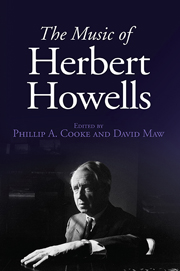Book contents
- Frontmatter
- Dedication
- Contents
- List of Illustrations
- List of Musical Examples
- List of Tables
- List of Contributors
- Foreword
- Acknowledgements
- Miscellaneous Frontmatter
- Introduction: Paradox of an Establishment Composer
- PART I Howells the Stylist
- 1 ‘In matters of art friendship should not count’: Stanford and Howells
- 2 Howells and Counterpoint
- 3 Window on a Complex Style: Six Pieces for Organ
- PART II Howells the Vocal Composer
- PART III Howells the Instrumental Composer
- PART IV Howells the Modern
- PART V Howells in Mourning
- Appendix: Catalogue of the Works of Herbert Howells
- Bibliography
- Index of Works
- General Index
3 - Window on a Complex Style: Six Pieces for Organ
from PART I - Howells the Stylist
Published online by Cambridge University Press: 05 December 2013
- Frontmatter
- Dedication
- Contents
- List of Illustrations
- List of Musical Examples
- List of Tables
- List of Contributors
- Foreword
- Acknowledgements
- Miscellaneous Frontmatter
- Introduction: Paradox of an Establishment Composer
- PART I Howells the Stylist
- 1 ‘In matters of art friendship should not count’: Stanford and Howells
- 2 Howells and Counterpoint
- 3 Window on a Complex Style: Six Pieces for Organ
- PART II Howells the Vocal Composer
- PART III Howells the Instrumental Composer
- PART IV Howells the Modern
- PART V Howells in Mourning
- Appendix: Catalogue of the Works of Herbert Howells
- Bibliography
- Index of Works
- General Index
Summary
The compositional style of Herbert Howells, the essence of which is admittedly difficult to articulate, seems to generate scholarly descriptions that fall into two categories. The first may be illustrated by some phrases of Christopher Palmer, taken from his discussion of Howells's impressionistic tendencies: ‘… the lines indeterminate and soft-drawn, the sum-total of texture a complex seen mistily through a haze of water or light … effortless interweaving of myriad coloured strands, fluid, self-generating, kaleidoscopic …’. Such lofty and picturesque language, with an emphasis on visual metaphor, is common in attempts to describe a sound-world that can be mystifying even to the most astute listener. Then there is the contrasting clinical assessment, exemplified by a report of Howells's ‘basic style’ as ‘tonal … but with modal incursions, diatonic dissonance, cross-relations, pedal points and suspensions, as well as asymmetrical phrases, rhythmic vitality, and confident melodies’. Assured that the devil is in the details, proponents of this perspective dissect and parse the music note by note, chord by chord, phrase by phrase, anticipating an epiphany. But neither the ‘laundry list’ of techniques nor Palmer's abstract portrait fully succeeds in capturing Howells's stylistic identity or explicating his achievements. A synthesis of these contrasting methodologies is necessary, and collections like the Six Pieces for Organ (HH 226) provide fertile ground for study of Howells's own integration of macrocosmic and microcosmic approaches to composition. These pieces offer an excellent window into Howells's style, with all the complexity that such a style embraces, yet without the intimidating vastness of a larger-scale work.
- Type
- Chapter
- Information
- The Music of Herbert Howells , pp. 37 - 60Publisher: Boydell & BrewerPrint publication year: 2013

